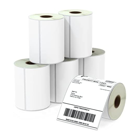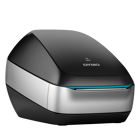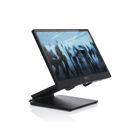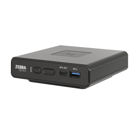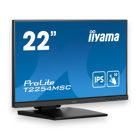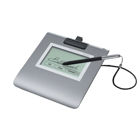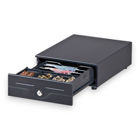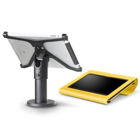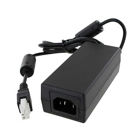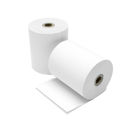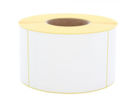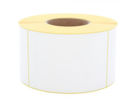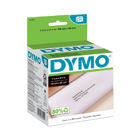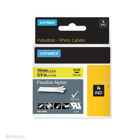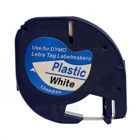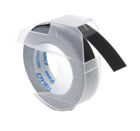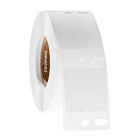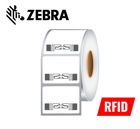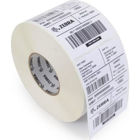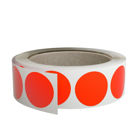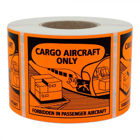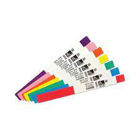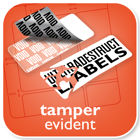Zebra Direct Thermal Labels
There are two thermal printing methods: direct thermal and thermal transfer. Each method uses a thermal printhead that applies heat to the surface being marked. Direct thermal printing uses chemically treated, heat-sensitive media that blackens when it passes under the thermal printhead, while thermal transfer printing uses a heated ribbon to produce durable, long-lasting images on a wide variety of materials.
Overall thermal label printers are ideal for barcode printing because they produce accurate, high-quality images with excellent edge definition. Thermal printers are engineered to print within tight tolerances and to produce the exact bar widths that successful barcode printing and scanning require. Each technology can produce one- and two-dimensional barcode symbologies, graphics and text at the same print resolutions and speeds.
Because they print without a ribbon, direct thermal printers are noted for their simplicity. Direct thermal printed labels typically have a considerable shelf life but are not well suited for environments that expose them to heat, long periods of direct sunlight, or abrasion. Direct thermal printers have no ink, toner, or ribbon.
Thermal transfer printed labels are easily identified by the crisp, often glossy, printed surface. The clarity is achieved by using a thin ribbon roll that when heated by the printhead melts onto the label to form the image. The ink is absorbed so that the image becomes part of the media. When matched with suitable media, thermal transfer technology is not only impervious to heat and moisture, but the image cannot be rubbed off, making the printed labels the most durable available. An additional benefit of this technology is the continuity of the printed image. Because the color and density of the printed image is determined by the ribbon and the resolution of the printer, thermal transfer printing produces consistent, reliable printing on every label. This technique provides image quality and durability that is unmatched by other on-demand printing technologies.
126 x Zebra Labels 55x38mm Direct Thermal Z-Perform 1000D
Direct thermal labels, Zebra Z-Perform 1000D, material: uncoated paper, size: 54.5 mm × 38.1 mm, core: 19 mm, permanent acrylic adhesive, abrasion-resistant, white, rectangular, 126 labels per roll, 40 rolls per box, compatible with Zebra ZQ310 mobile printers.
- Label & Material
- Direct thermal uncoated paper
- White rectangular design
- Abrasion-resistant surface
- Label size: 54.5 x 38.1mm
- Core diameter: 19mm
- 126 labels per roll / 40 rolls per box
- Permanent acrylic adhesive (FDA 175.105 compliant
- Strong adherence for general purpose applications
- Compatible with Zebra ZQ310 mobile printers
Dimensions & Output
Adhesive & Compatibility
2780 x Zebra Labels 31 X 22mm Direct Thermal
3007208-T
31mm X 22mm
Permanent Adhesive, Perforation, Premium Topcoated
2780 Labels Per Roll on 25mm Core
Outer Diameter: 127mm
Price is per roll
Zebra Z-Select 1000D 5037 Labels 24mm x 11mm Direct Thermal
Print Technology: Direct Thermal (No Ribbon Needed)
Core Diameter: 25 mm
Adhesive Type: Permanent
Number of Labels per Roll: 5037
Price per roll
Zebra Z-Select 2000D 57.15mm x 50.8mm Direct Thermal Label
Zebra Z-Select 2000D - Direct Thermal Perforated Paper Label with Permanent Adhesive. No Ribbon Required
57.15mm x 50.8mm
1370 Labels Per Roll on 25mm Core
Price is per roll
Zebra Z-Perform 1000D 38mm x 25mm Direct Thermal Labels
Zebra Z-Perform 1000D - Uncoated Direct Thermal Paper Label with Permanent Adhesive. No Ribbon Required
38mm x 25mm
2580 Labels Per Roll on 25mm Core
Price is per roll
Z-Select 2000D 51 x 25mm Direct Thermal Label
Zebra Z-Select 2000D - Top Coated Direct Thermal Paper Label with Permanent Adhesive. No Ribbon Required
50.8 x 25.4mm
2580 Labels Per Roll on 25mm Core
Price is per roll
Zebra Z-Perform 1000D 76.2mm x 50.8mm Direct Thermal Label
Zebra Z-Perform 1000D - Uncoated Direct Thermal Paper Label with Permanent Adhesive. No Ribbon Required
76.2mm X 50.8mm
1370 Labels Per Roll on 25mm Core
Price is per roll
Zebra Z-Select 2000D 76.2 x 25.4mm Permanent Direct Thermal
Format same as: Zebra Z-Select 2000D, 800263-105
76.2mm x 25.4 mm
Perforated
2580 Labels Per Roll on 25mm Core and 121mm outer diameter
Price is per roll
Zebra Z-Select 2000D 101.60mm x 127mm Direct Thermal
Zebra Z-Select 2000D - Uncoated Direct Thermal Paper Label with Permanent Adhesive. No Ribbon Required
101.60mm x 127mm
565 Labels Per Roll on 25mm Core
Price is per roll
Zebra Z-Perform 1000D 101.6mm x 152.4mm Direct Thermal Label
Zebra Z-Perform 1000D - Uncoated Direct Thermal Paper Label with Permanent Adhesive. No Ribbon Required
101.6mm x 152.4mm
475 Labels Per Roll on 25mm Core
Price is per roll
1790 x Zebra Labels 101.6 X 38.1mm Direct Thermal
Zebra Z-Perform 1000D, 880191-038D
101.6mm X 38.1mm
No Perforation
1790 Labels Per Roll on 25mm Core
Price is per roll
Zebra 8000D 56 x 13mm Direct Thermal Jewellery Tag Label
The Zebra 8000D 56 x 13mm Direct Thermal Jewellery Tag Label offers a durable, no-ribbon-required labelling solution for jewellery. With a gloss polypropylene finish, UV coating, and black mark sensing, these butterfly labels provide excellent scratch, smear, and chemical resistance, ensuring your jewellery tags stay intact and legible.
Compatible Printers: GC420t, GK420t, TLP 2844-Z, TLP 3842, TLP 3844-Z, TLP 2844, GX420t, GX430t, ZD421, ZD220, ZD230
Zebra 8000D 56 x 13mm Direct Thermal Jewellery Tag White
The Zebra 8000D 56 x 13mm Jewellery Tag is a durable, white, coated polypropylene label designed for tagging jewellery. Featuring a permanent acrylic adhesive and excellent UV resistance, it ensures reliability and longevity for your labelling needs.

